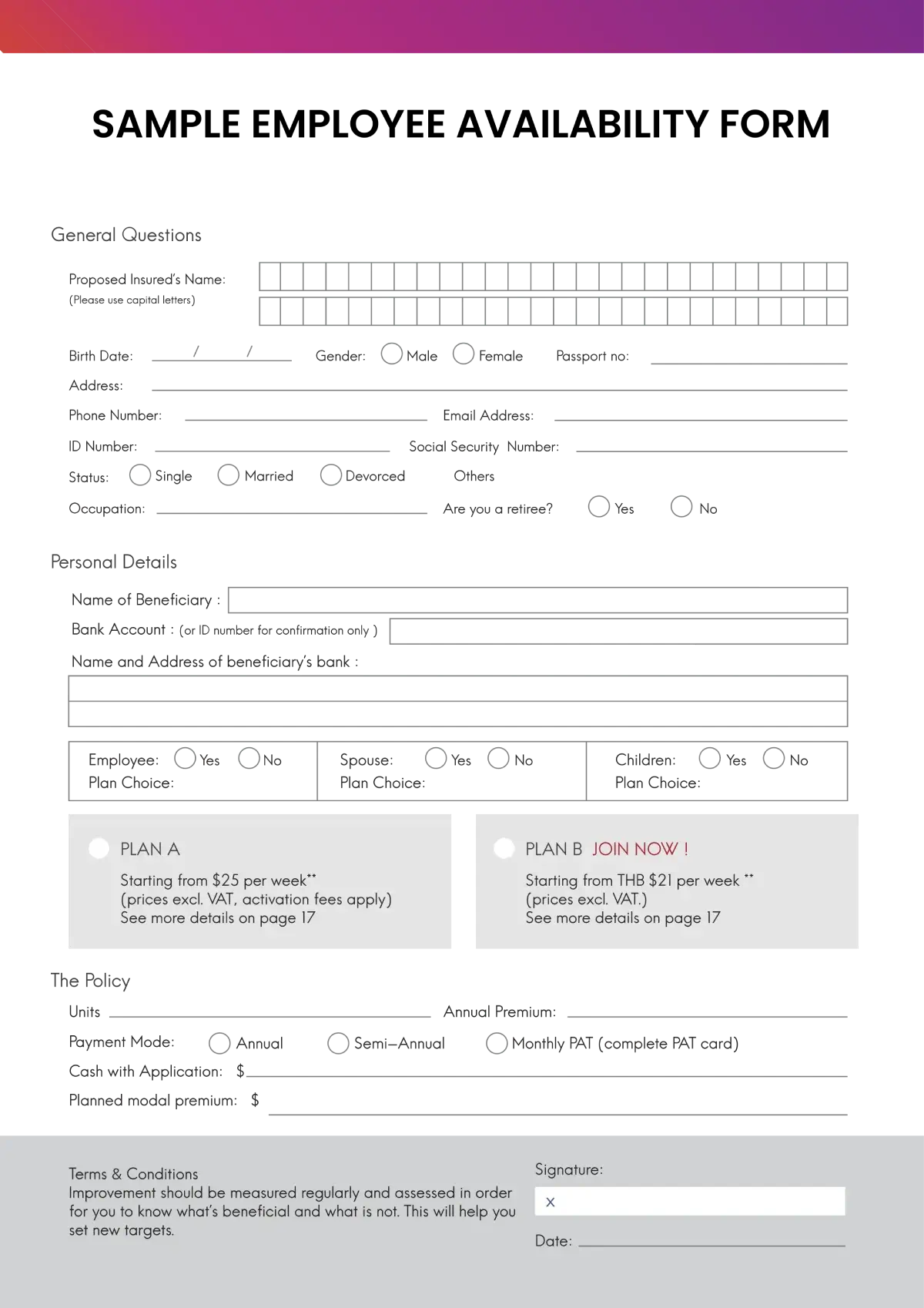Home / E / Employee Availability Form
Employee Availability Form: Meaning, Tips, Uses & Template
Dealing with shift work and adequate staffing is not a new issue in business, particularly for businesses with hourly or part-time employees. Employee availability forms give structuring opportunities for employers and employees to communicate workplace preferences and restrictions. When an employee completes the availability form, this identifies when the employee is available to work. Doing so prevents missed shifts, increases employee satisfaction, and helps simplify and identify when employees are scheduled accurately.
This blog will discuss what employee availability forms are, how they can be used, and why they are important, while also outlining best practices, common pitfalls, including how web-based applications such as Time Champ can facilitate using employee availability forms. Plus, to assist you in using or referring to an employee's availability.
What is an Employee Availability Form?

An employee availability form is a document used by the staff or employees to record their wants and needs for working hours. Employers utilize this information to schedule shifts to the best of their ability based on availability, while also trying to eliminate conflict quickly and efficiently as needed.
The primary purpose of this form is to enable employees to schedule their work hours only when they are willing and able to work, while allowing employers to manage shifts accordingly. It reduces the likelihood of getting last-minute call-ins to cover shifts and can help minimize staffing shortages when the workplace gets busy in non-regular scheduled hours. Additionally, this also increases productivity, because the morale of employees increases when they can work during their convenient times.
Normally, HR departments or shift managers will obtain the staff work availability sheets when trying to set the work schedule, while managing shift changes often. In smaller businesses or organizations, this task may fall under the duties of a store manager. However, in larger organizations, this is often addressed using workforce management software.
Employers can use employee availability sheets to standardize request processing for working hours. This will enable clarity and communication between employers and employees, allow for trust building, and better preparation for employers, especially in certain sector jobs, such as retail, hospitality, and healthcare, due to rapid schedule changes and fluctuation.
What are the Benefits of Using an Employee Availability Form?

- Reduces Scheduling Conflicts
Managers can prevent shift conflicts by asking employees to share their preferred work schedules a few months ahead of time. Employees will not proactively swap shifts, call out, or create chaos for the schedule.
- Enhances Employee Satisfaction
When staff feel respected and valued when it comes to their time constraints and preferences, they become more engaged, productive, and loyal. Happy employees are more productive, according to a study done by the University of Oxford.
- Enhances Operational Efficiency
By aligning employees available to work with the organisation's peak hours, businesses ensure they are covered without incurring unnecessary labour costs. These practices should lead to better service delivery. For those businesses using an availability tracking tool, a decrease in missed shifts has been reported.
- Significantly Eases Shift Scheduling
Scheduling becomes efficient and uncomplicated because your managers have an understanding of who wants in and when. This provides for a comfortably balanced and fair schedule. Using this method will save hours of scheduled work attempting to fulfil minor adaptations, like shift changes, employee leave, or increased staffing coverage due to last-minute staff shortages.
- Helps Maintain Legal Compliance
For businesses hiring minors or part-time employees, availability sheets are helpful to avoid mis-scheduling shifts outside of legal limits. This is especially important to be compliant with laws around maximum hours worked, rest breaks, or more general rules around employees' schedules.
- Promotes Better Communication
The availability sheet opens direct lines of communication with management and other employees, which minimizes misunderstandings or assumptions about who is available and when. The sheet supports the culture of transparency and trust.
- Supports Evidence-Based Decisions
Electronic employee availability sheets can be tracked over time for analytics so owners or managers can identify trends in busy times or patterns of absence. This information will allow you to find the best new schedule, while being a fact-driven decision for your staffing or business decisions.
What Should be Included in an Employee Availability Form?
- Basic Employee Information
You might want to collect the employee's name, department, contact information, and position on the form to keep it organized and traceable.
- Availability by Day and Time
You should develop a table or grid every week to capture availability for each day in blocks of time (morning, afternoon, evening).
- Preferred Shifts
This section can emphasize shifts that the employee prefers. This can create an opportunity for productivity and satisfaction.
- Unavailable Times
This section can capture days and times the employee is unavailable because of commitments made previously.
- Notes or Comments
You should allow for additional notes like preferred days off, class schedule, or childcare.
- Signature and Date
To foster accountability, the form should be signed and dated by the employee and verified by the supervisor or HR.
What Mistakes Should You Avoid with Availability Forms?
- Not Updating Regularly: Availability can change due to personal or seasonal reasons. Failing to update can result in scheduling errors.
- Employees are Always Available: This leads to employee burnout and conflict from unverified assumptions.
- No Standardized Format: The inconsistent or unclear formatting of data makes data entry difficult and can result in mistakes made during entry.
- Don't Follow Employee Shifts: Not listening to shifts leads to dissatisfied employees and turnover.
- Ignoring Employee Preferences: Neglecting preferred shifts can cause dissatisfaction and higher attrition rates.
How to Use an Employee Availability Form Effectively
To leverage availability forms to their fullest potential, collect them during onboarding and update them every 3-6 months or whenever they change. Be open to suggesting them and support them in talking with you about any potential changes in schedule availability.
Use cloud-based solutions in a digital manner so the forms are easily available, editable, and can be shared. Double-check that you have met all legal requirements in support of fair and compliant scheduling. Identify one learned manager to take responsibility for the work availability sheet, so there is no duplication or miscommunication.
Use employees' feedback for betterment in the future. If you do it right, the forms will provide a useful scheduling tool, and they will not just be another piece of paperwork.
How Does Time Champ Keep Your Employee Availability Current?
Time Champ's smart scheduling and workforce management solution includes integrated employee availability tracking capabilities. Through automatic reminders, digital notifications, and real-time forms that can be uploaded by employees on their mobile devices, employees can still adjust/update availability from anywhere in the workplace.
For managers, you can look at availability in real-time, which reduces the difficulty of scheduling shifts and avoids unintentional changes. The combination of availability information with attendance (time-off requests), employee productivity, shift patterns, Time Champ keeps all staffing decisions as optimized as possible.
Whether managing a small team or an incredibly large workforce, Time Champ makes the workflow of employee availability sheets seamless and simplified. As an added benefit, you'll gain increased accuracy and efficiency related to productivity.

